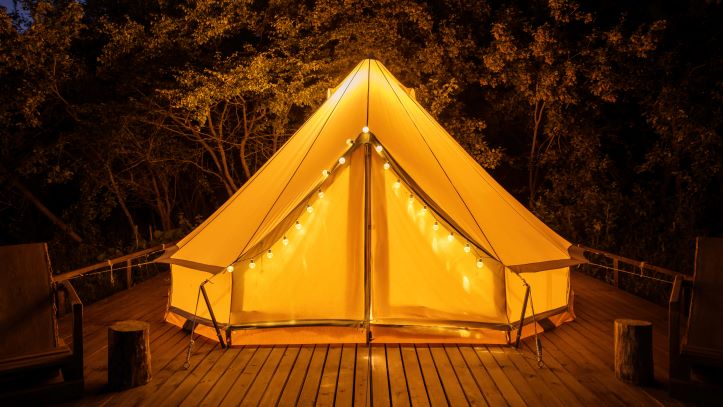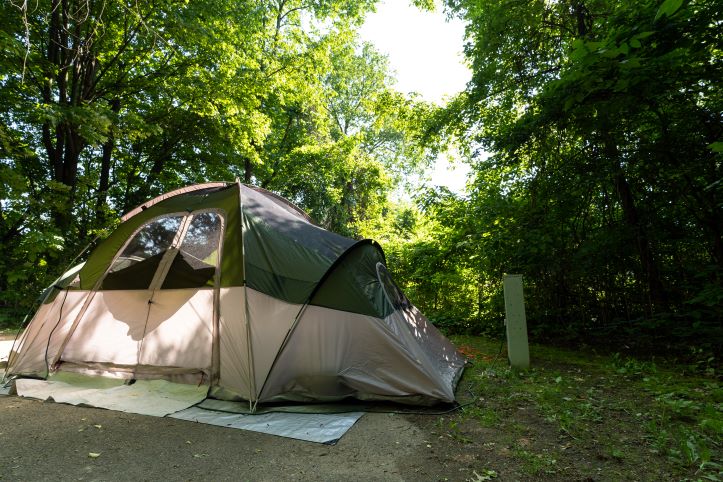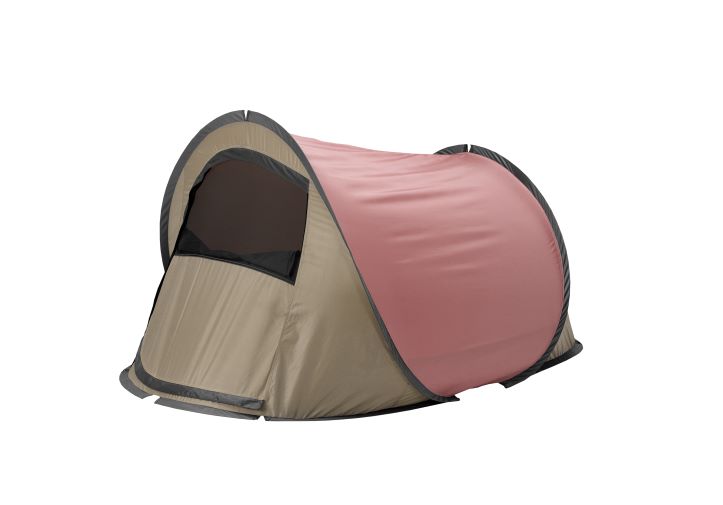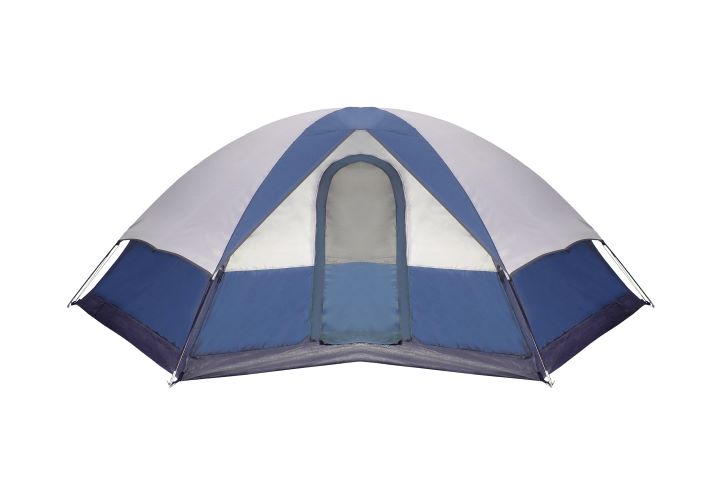Knowing what is a tent made of is important. Because tents hold a special place in the hearts of outdoor enthusiasts. It serves as their portable sanctuaries in the midst of nature’s embrace. These simple huts become our homes away from home when we go camping, providing a warm refuge from the outside world.
But have you ever given thought to the components used to make these indispensable friends? It’s fascinating to learn what goes into building a tent, and knowing this information is crucial for making good decisions. Every camping trip requires a special tent, one that can survive the elements and still keep you comfortable.
Through this investigation, we will learn more about the fabrics that give tents their durability, weatherproofing, and stability. Understanding the construction of these tents can help you choose the best one for your next camping trip. Join me on this adventure as I show you the incredible world of tent making!
The Fabric: Shielding You from the Elements
When it comes to protecting yourself from the elements of nature, the outer layer of your tent is where your choice of cloth really counts. Let’s have a look at some of the most common tent building materials, focusing on their durability and weather resistance, as well as their benefits and cons.

Nylon Tent Material
Nylon is frequently used for tent textiles because of its low weight and high strength. Its strength and resistance to wear make it an excellent choice for use in harsh environments. Nylon is an excellent material for weatherproof clothing after being treated with a waterproof coating.
Nylon, on the other hand, can sag when wet and may stretch with use. It should be noted that its resistance to ultraviolet light is lower than that of other materials.
Backpackers and hikers generally prefer nylon tent material due to its portability, durability, and versatility in use.
Pros
- Lightweight, strong, and abrasion-resistant.
- Provides excellent waterproofing when treated with a coating.
- Easy to pack and transport.
Cons
- Can sag when wet, may stretch over time.
- Not as resistant to UV rays compared to other fabrics.
Verdict
Nylon is a popular choice for backpackers and hikers due to its lightweight nature and good overall performance in various weather conditions.

Polyester Tent Material
Polyester is a strong fabric that keeps its shape consistently, making it an excellent choice for tents. It provides excellent protection against ultraviolet radiation, making it suitable for use in the open air. Polyester fabrics with a waterproof coating are highly recommended for use in wet environments.
This material dries rapidly and needs little care. Polyester, on the other hand, is heavier than nylon and may not be as breathable as other textiles. However, when strength and resilience to the elements are of utmost importance, polyester tent material is a good option for ordinary camping and outdoor activities.
Pros
- Durable, retains shape well, and resistant to UV rays.
- Offers excellent waterproofing with a coating.
- Quick-drying and low-maintenance.
Cons
- Not as breathable as some other fabrics.
- Heavier compared to nylon.
Verdict
Polyester is a reliable choice for general camping and outdoor activities. It provides good durability and weather resistance.

Ripstop Tent Material
Ripstop fabric was developed to be more durable against tears. It’s great for rough excursions because of the grid structure that reinforces it and keeps tears from spreading. Ripstop materials are sturdy and long-lasting, making them a reliable addition to your tent in harsh climates.
However, it’s important to keep in mind that ripstop textiles are typically a tad heavier than standard nylon or polyester. Ripstop fabric is a good option if you’re concerned about wear and tear on your trips.
Pros
- Features a reinforcing grid pattern that enhances tear resistance.
- Durable and able to withstand rough conditions.
Cons
- Slightly heavier than regular nylon or polyester fabrics.
Verdict
Ripstop fabric is an excellent option for those seeking added durability and resistance against tears during their adventures.

Cuben Fiber (Dyneema)
If you’re looking for ultralight gear that doesn’t skimp on durability and toughness, go no further than Cuben Fiber, often known as Dyneema. Amazingly strong and durable for such a lightweight tent material, it can withstand the elements for years. Because of its inherent water-repellent properties, Cuben Fiber does not need to be coated in order to be waterproof.
It’s worth noting that Cuben Fiber is typically more expensive and less commonly available than other fabrics. Cuben Fiber is a great choice if you’re an ultralight traveller or adventurer who values portability above bulk while still needing high levels of performance from their gear.
Pros
- Exceptionally lightweight, yet incredibly strong and tear-resistant.
- Provides excellent waterproofing without the need for coatings.
Cons
- Expensive compared to other fabrics.
- Less widely available.
Verdict
Cuben Fiber, or Dyneema, is ideal for ultralight backpackers and adventurers who prioritize weight savings without compromising on durability.

Polycotton (Canvas)
Polycotton, sometimes known as canvas, is a popular tent material that combines the best features of polyester and cotton. Its high breathability means less condensation inside the tent thanks to increased airflow. Polycotton textiles have insulating capabilities and make the tent seem warm and inviting.
They also have a high level of condensation resistance, making for a dryer camping trip. However, polycotton fabrics are thicker and heavier than their synthetic counterparts. And it’s a pain to move around and takes forever to dry out after getting wet. When durability and comfort are of paramount importance, such as on an extended camping trip or a family vacation, polycotton is the material of choice.
Pros
- Breathable, offers excellent insulation, and resists condensation buildup.
- Durable and long-lasting.
- Provides a cozy and comfortable feel.
Cons
- Heavier and bulkier compared to synthetic fabrics.
- Requires more maintenance and longer drying time.
Verdict
Polycotton, often referred to as canvas, is perfect for long-term camping, family outings, or base camps where comfort and longevity are key considerations.

Silnylon (Silicone-coated Nylon)
Silnylon is a fabric that combines the advantages of nylon (such as its light weight and strength) with a silicone coating (which makes the fabric more waterproof). It provides effective defense against precipitation, keeping the inside of your vehicle dry and pleasant. Fabrics made from silnylon may withstand sunlight without deterioration.
The price of silnylon is higher than that of conventional nylon, but it is well worth it because of its optimal combination of light weight, strength, and resistance to the elements. Backpackers and explorers who value dependable performance without adding unnecessary bulk may consider this option.
Pros
- Combines the benefits of nylon (lightweight, strength) with silicone coating for enhanced waterproofing.
- Resistant to UV rays.
Cons
- Can be slightly more expensive than regular nylon.
Verdict
Silnylon strikes a balance between weight, durability, and weather resistance, making it a solid choice for backpackers and adventurers seeking reliable performance.
The Framework: Structure and Stability
The framework of a tent is essential because it gives the tent its shape and stability, allowing it to withstand wind and rain. Let’s take a look at the tent’s primary parts, the tent poles, and the advantages and disadvantages of each. The advantages of novel designs, such as inflatable tent frames, will also be discussed.
There are a few key parts to a tent’s framework that, when put correctly, make for a solid and secure shelter. Couplers, tent poles, and guy lines are all part of this set. Tent poles serve as the framework’s central support structure, allowing the tent to maintain its intended form and shape.
Tent Poles
Aluminum Poles
- Pros: Aluminum poles have the advantages of being easy to handle, long lasting, and not rusting. They are perfect for use while traveling or camping due to their high strength-to-weight ratio.
- Cons: Aluminum poles can be relatively expensive compared to other materials. They may conduct heat or cold, affecting the tent’s internal temperature in extreme weather.
Fiberglass Poles
- Pros: Fiberglass poles can resist high winds and absorb shock for a reasonable price. Because they conduct no electricity, they are also safe to use during lightning storms.
- Cons: Fiberglass poles are heavier compared to aluminum poles and can be prone to breakage if not handled carefully.
Learn what are tent poles made of for further knowledge.

Connectors
Connectors are the connectors between tent poles that allow for stability and convenience during assembly. They are often manufactured from long-lasting materials like metal or plastic. The tent’s design and manufacturer will determine the type of connector utilized. To guarantee the structural integrity of the tent as a whole, high-quality connectors are required.
Guy Lines
Tents require guy lines, which are ropes tied to the framework and staked or anchored to the ground. They aid in stress distribution and offer stability, particularly in gusty situations. Tents require guy lines to keep them from drooping or collapsing due to lack of tension.
New possibilities in tent frameworks have been made possible by creative tent designs, providing campers with more choices who value portability and ease of setup. Inflatable tent frames are one such design; these tents’ frames are made from tubes filled with air rather than poles. The many advantages of inflatable tents include:
- Quick and effortless setup: Inflating the tent is often a matter of minutes, reducing the time and effort required for pitching.
- Lightweight and compact: Inflatable tent frames can be deflated and packed into a compact size, making them easier to transport.
- Versatility: Inflatable tents can adapt to uneven terrain, offering more flexibility in choosing the camping spot.
- Reduced risk of damage: Inflatable tent frames are less prone to breakage compared to traditional poles, offering increased durability.
The Zippers and Seams: Keeping Nature at Bay
If you want your tent to last, you need to put a premium on the quality of its zippers and seams. These seemingly insignificant factors have a major impact on your ability to stay dry and comfortable when camping. Let’s look into why it’s important to have high-quality zippers and seams, the many kinds of zippers used in tents, and how to seal seams to make them more watertight.
Zippers: Your tent’s zippers serve as its guardians, letting you in and out while keeping the elements and pests out. The effectiveness and durability of a tent are directly related to the quality of its zipper.
- Coil Zippers: Tents typically have coil zippers because they are long-lasting and simple to use. They move along a track on the basis of interlocking metal or plastic coils. When it comes to ease of use, nothing beats the convenience of a coil zipper.
- Waterproof Zippers: Waterproof zippers are built specifically to prevent the infiltration of water. It’s used as a tent material because it’s waterproof. These zippers are coated or laminated with a specific material. It seals up the zipper teeth, so no water can enter the tent through them.
Seams: The tent’s seams connect the various pieces of cloth that make it up. If they aren’t tightly sealed, water can leak in through them.
- Seam Sealing Techniques: Tents are made more watertight through the use of seam sealing procedures by manufacturers. Waterproof tape or sealer is applied to the seams to prevent water from seeping in. If you take the time to seal the seams, you won’t have to worry about getting wet even if it rains a lot.
It’s important to remember that not all tents are sold with their seams already sealed. In such a circumstance, it’s best to apply seam sealer on your own, per the directions provided by the manufacturer. Maintaining the tent with routine care and reapplying seam sealant at regular intervals will keep it watertight for as long as possible.
Additional Features: Enhancing Your Camping Experience
Although a tent’s principal use is as a place to stay dry during bad weather. These days, it’s not uncommon to find upgraded conveniences like electricity and running water with camping gear. Comfort, convenience, and general satisfaction can all benefit greatly from these supplementary features. Mesh panels, ventilation systems, and rainfly attachments are all frequent extras in tents. So let’s have a look at their function and benefits.
Mesh Panels
Mesh panels are commonly used to cover the tent’s body or doors. Most commonly, these panels are crafted from fine mesh fabric that permits more airflow while yet excluding insects. Mesh panels have two functions: they allow air to circulate and they keep insects out of the house.
Condensation inside the tent, stuffiness, and an uncomfortable climate are all things that can be avoided with proper ventilation. Mesh panels also provide privacy without sacrificing the expansive vistas of the natural world beyond.
Ventilation Systems
Tents with built-in ventilation systems are more comfortable to stay in because of the consistent airflow and temperature. Adjustable windows, vents, and vents in the rainfly are common components of such systems. You may adjust the airflow to your liking regardless of the weather by opening and closing the appropriate vents.
Condensation can be reduced, air quality can be maintained, and overheating can be avoided with good ventilation on hot days. The quality of your camping trip will greatly increase with the installation of better ventilation.
Rainfly Attachments
Many tents have rainfly attachments that act as a second line of defense from the elements, such as water, wind, and sunlight. The rainfly protects the tent from rain and other wet weather by draping over the main tent structure. When it rains, it helps keep the tent dry inside and out.
Depending on your needs and the weather, rainflies can be permanently affixed or come with removable choices. In addition to increasing protection from rain and wind, a rainfly can be used to block the sun’s rays on hot days.
Gear Storage Options
Vestibules, pockets, and gear lofts are just some of the storage options that may be found on some tents. A vestibule is an antechamber or foyer that extends beyond the main sleeping room and provides shelter for items such as backpacks, boots, and cooking utensils.
Small goods, including phones, headlamps, and camping accessories, can be stored in the tent’s pockets or gear lofts for easy access. These compartments keep your belongings out of the way but still within easy reach and out of the elements, making for a more relaxing and restful night’s sleep.
What Are Old Tents Made Of?
In case you’re interested in learning more about the historic tents. How did they get made? This section, fortunately, has the relevant information. The sight of a vintage tent may evoke pleasant memories of bygone camping trips. There’s something endearing and nostalgic about these relics of the past, but have you ever pondered what kind of materials were used to build them? Let’s investigate the make-up of vintage tents and find out which materials have withstood the test of time.
Canvas
In the past, canvas was commonly used to make tents. This sturdy woven fabric, most commonly manufactured from cotton, was exceptionally long-lasting and resistant to wear and tear, as well as the elements. Canvas tents were well-known for their durability in the face of harsh weather, making them an excellent option for extended periods of camping and adventuring. However, in order to keep their structural integrity, canvas tents needed frequent maintenance, such as waterproofing treatments and appropriate storage.
Wool
In rare circumstances, wool was used as a material in vintage tents. Wool is a natural material that can naturally insulate and resist moisture. Tents made of wool were highly sought after because of their capacity to keep in heat, making them ideal for use in colder climes. Wool tents were heavier and trickier to dry than those made from other fabrics, restricting their utility in some situations.
Oilcloth
Oilcloth was also commonly used in traditional tents. It is a water-resistant cotton fabric with a tight weave that is coated with oil or wax. Because of this treatment, oilcloth tents were excellent rain shelters for campers. However, oilcloth tents needed regular upkeep to avoid the fabric drying up and breaking.
Leather
Leather was used in several classic tents, especially to reinforce stress points and as a decorative accent. The tent’s most important structural elements were reinforced with leather for longevity and strength. Although it wasn’t the main material, leather details gave vintage tents an air of handiwork and rustic charm.
It’s fascinating to observe how ancient tents were made from sturdy, weatherproof natural materials. Though not as popular now, these supplies attest to the resourcefulness of pioneer campers in their pursuit of weatherproof abodes in the great outdoors.
Conclusion
Choosing the best tent for your outdoor adventures requires an understanding of tent materials. Important fabric options, framework parts, zippers and seams, and extras have been covered. The materials used to make a tent can greatly affect its longevity, resistance to the elements, airflow, and usability.
The key to a relaxing camping trip is making a well-informed selection based on the information provided here. So before you head out on your next camping trip, do some reading up on the different materials used in tents so you can choose the best one for your needs.
